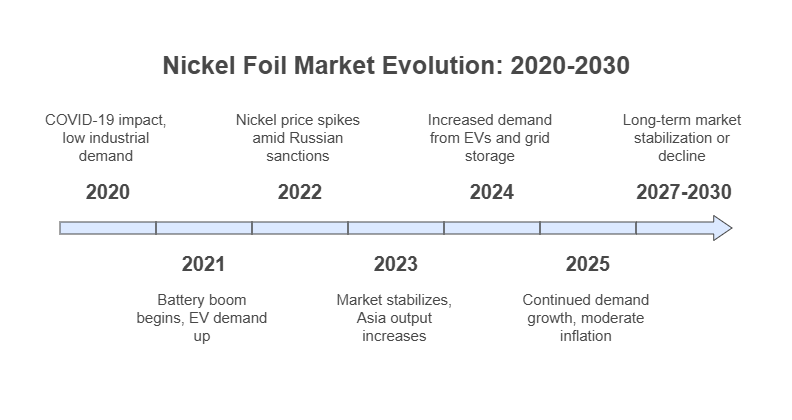Nickel foil is a critical material widely used in electronics, energy storage, aerospace, and advanced manufacturing industries. With the rising demand for battery technologies and miniaturized electronics, nickel foil prices have become a key focus for manufacturers and investors alike. This article provides a comprehensive breakdown of nickel foil pricing in 2025, examining influencing factors, regional differences, historical data, and expected market movements.

What is Nickel Foil and Why is it Important?
Nickel foil is a thin sheet of pure nickel or nickel alloy typically produced in thicknesses ranging from 0.01mm to 0.2mm. Its high corrosion resistance, electrical conductivity, and mechanical strength make it a preferred material in:
• Lithium-ion batteries – as a current collector or substrate
• Printed circuit boards (PCBs)
• Hydrogen production and fuel cells
• Aerospace sensors and actuators
Nickel Foil Price in 2025: Overview
Nickel foil prices in 2025 have experienced moderate fluctuation due to supply chain adjustments, rising raw material costs, and evolving global demand. The average price for commercially pure nickel foil in 2025 is estimated as follows:
| Region | Price Range (USD/kg) | Grade | Thickness |
|---|---|---|---|
| North America | 62 – 78 | 99.6% Ni | 0.02 mm |
| Europe | 65 – 80 | 99.8% Ni | 0.05 mm |
| China | 48 – 63 | 99.5% Ni | 0.01 mm |
| Japan | 70 – 85 | 99.9% Ni | 0.02 mm |
| India | 50 – 68 | 99.6% Ni | 0.02 mm |
Price Trends from 2020 to 2025
| Year | Average Price (USD/kg) | Market Notes |
|---|---|---|
| 2020 | 35 | COVID-19 impact, low industrial demand |
| 2021 | 45 | Battery boom begins, EV demand up |
| 2022 | 58 | Nickel price spikes amid Russian sanctions |
| 2023 | 61 | Market stabilizes, Asia output increases |
| 2024 | 64 | Increased demand from EVs and grid storage |
| 2025 (YTD) | 67 | Continued demand growth, moderate inflation |
Factors Affecting Nickel Foil Prices in 2025
1. Raw Nickel Prices: Nickel foil cost directly correlates with the price of LME nickel. In 2025, LME nickel prices have averaged around $18,000–$21,000/ton.
2. Processing and Rolling Costs: Ultra-thin foil production requires advanced rolling and annealing technologies, contributing significantly to cost.
3. Regional Energy Prices: Electricity-intensive production processes mean that local energy costs (especially in China and Europe) heavily affect the price.
4. Supply Chain Stability: Disruptions in nickel mining (especially in Indonesia and the Philippines) have impacted global foil output and price.
5. ESG Regulations: Companies shifting to sustainable nickel sources or reducing carbon emissions often price these costs into the final product.
Applications Driving Demand in 2025
Battery-grade nickel foil remains the strongest demand segment. Notable applications include:
| Application | Industry | Specification |
|---|---|---|
| Battery Collector Foil | EV / Energy Storage | 0.01 – 0.02 mm, 99.9% Ni |
| Flexible PCB | Consumer Electronics | 0.03 – 0.05 mm, 99.5% Ni |
| Fuel Cell Membrane | Hydrogen Industry | 0.02 mm, high-purity Ni alloy |
| Thermal Shielding | Aerospace | 0.05 mm, nickel alloy |
Nickel Foil Price Forecast: Short-Term vs Long-Term
Short-Term (2025–2026): Prices are expected to remain within the $65–$75/kg range, with some volatility due to geopolitical events and EV demand shifts.
Long-Term (2027–2030): As nickel recycling increases and supply chains mature, prices may stabilize or slightly decline, depending on technological innovations in battery chemistry (e.g., solid-state batteries, lithium-iron alternatives).
Regional Production Capacity Comparison
| Country | Major Producers | Annual Capacity (tons) |
|---|---|---|
| China | Jinchuan, GEM Co. | 10,000+ |
| USA | Ulbrich, Goodfellow | 1,500 |
| Japan | Sumitomo, Nippon Yakin | 2,000 |
| Germany | Vacuumschmelze | 800 |
What to Expect When Purchasing Nickel Foil in 2025
• Expect longer lead times due to high demand in Q3/Q4 driven by EV manufacturing cycles.
• MOQ (Minimum Order Quantities) are typically set at 5–50 kg, depending on supplier and thickness.
• Certification and testing requirements (RoHS, REACH, ISO9001) may impact delivery time and price.
Related Questions and Answers
What is the current price of nickel foil per kg?
As of mid-2025, the global average price of nickel foil ranges between $60 to $75 per kilogram, depending on thickness, purity, and region of purchase.
Where can I buy nickel foil in bulk?
You can source nickel foil from industrial material suppliers such as Jinchuan Group (China), Ulbrich (USA), and Sumitomo (Japan). Online platforms like Alibaba and Made-in-China also offer verified suppliers for bulk purchases.
What thickness of nickel foil is used in batteries?
The most common thickness for lithium battery applications is between 0.01 mm to 0.015 mm, typically made with 99.9% purity nickel or nickel-coated copper foil.



